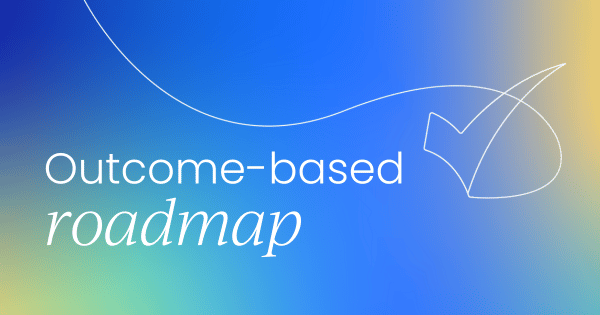What is an outcome-based roadmap?
Outcome-based (also known as outcome-driven) roadmaps are strategic plans focused on results and goals (rather than specific features).
This approach allows your team to prioritize solving key problems, instead of ticking off a feature list. It stresses how things look if your team succeeds, how your customers will feel, and what your users can now achieve.
By taking this approach, you can avoid being stuck delivering on a list of features, and instead, your whole team can own the problem.
The outcome-driven product mindset places more autonomy back within your teams and allows for more knowledge to be shared. You’ll have greater certainty on when an actual customer problem is solved, as opposed to when a particular feature is shipped.
When you gain clarity on outcomes, you’ll be able to realize a wider range of possibilities and gain better context for specific items on your product roadmap and their prioritization. At the same time, you’ll also be able to ensure the product strategy is still well communicated and consistently adhered to.
To provide a better understanding of the power of outcome-based product roadmaps, we sat down with Roman Pichler, Founder of Pichler Consulting and advocate for outcome-driven approaches.
Here’s what he had to say:
“Many product people I work with still use traditional feature-based roadmaps and are fairly new to the concept of outcome or goal-oriented roadmaps.
“The whole point is rather than focusing on output and deliverables, i.e, “what needs to be done?” try asking, “why do we want to enhance the product? What is the specific value that we want to create?” “What are the specific outcomes and goals we'd like to achieve?”
“That might be to acquire more users or customers, to increase engagement, to improve conversion, and to start generating revenue, etc. I think part of the reason why feature-based roadmaps are still dominant is that it’s hard to shrug off that traditional way of doing it.
“There's an interesting correlation between product roadmapping and the level of empowerment that product people have. I find that when product people aren't fully empowered, they're often given a feature-based roadmap and told to deliver.”
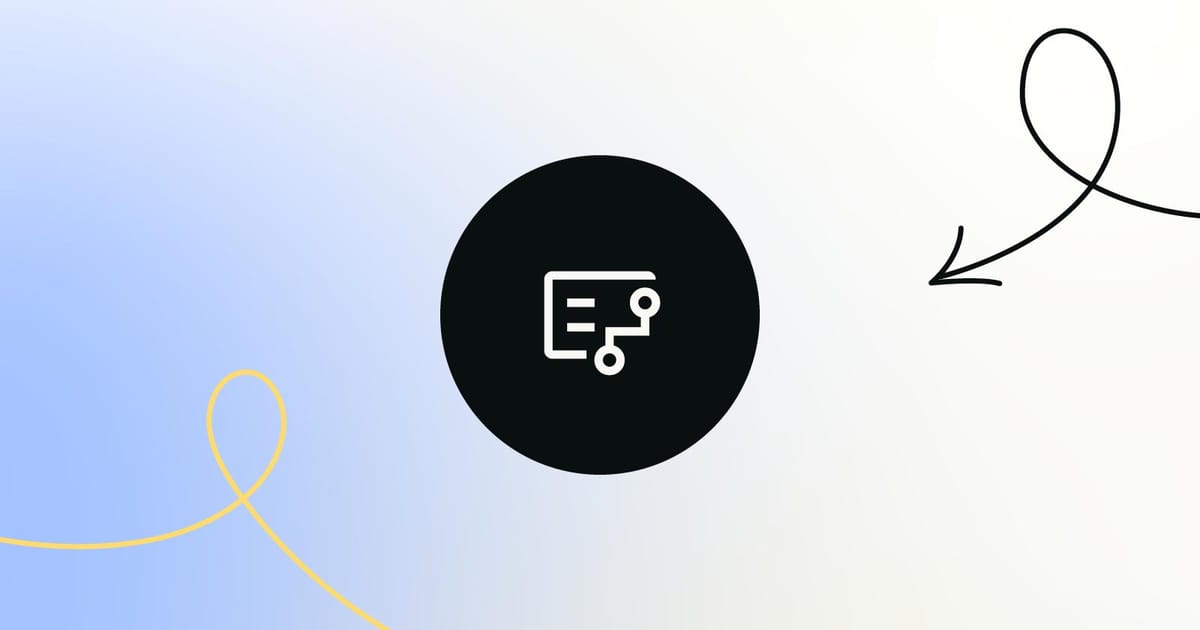
✅ Pros of Outcome-Based Roadmaps
1. Aligns teams around strategic goals
Outcome-based roadmaps start with the why — aligning product decisions with company objectives. This means every feature built, every sprint completed, and every experiment run has a clear purpose.
It’s a roadmap that not only guides work, but makes the work feel meaningful.
When everyone understands how their efforts contribute to the bigger picture, it builds a shared sense of ownership — and that boosts team morale and results.
2. Enhances flexibility in fast-changing markets
Unlike rigid, feature-packed plans, outcome-driven roadmaps leave room to adapt. When priorities shift — due to customer feedback, market changes, or new opportunities — your team can pivot without losing sight of the end goal.
3. Provides clearer success metrics
With outcomes as the foundation, measuring progress becomes a lot more straightforward. You're no longer just asking “Did we build it?”, but also, “Did it work?”
This focus makes it easier to evaluate ROI and hold meaningful performance conversations.
4. Encourages a user-centric approach
By tying product work to real customer problems, these roadmaps foster empathy and focus. Instead of mindlessly shipping features, you’re solving problems, delivering value, and improving experiences for your users.
5. Supports cross-functional collaboration
When the whole organization rallies around outcomes (not just tasks) it naturally breaks down silos.
Sales, marketing, product, and support teams all align on what needs to happen and why, accelerating decision-making and time to market.
⚠️ Cons of Outcome-Based Roadmaps
1. Requires strong strategic clarity and buy-in
If leadership hasn’t clearly defined strategic goals, teams may struggle to set meaningful outcomes. And if stakeholders aren’t on board with this new way of thinking, there’s a risk of slipping back into familiar (but less effective) feature-first habits.
Without top-down support, outcome-based roadmapping becomes just another buzzword — not a working strategy.
2. Can be resource-intensive to maintain
Defining outcomes, gathering insights, measuring impact — it all takes time, effort, and often specialized skills. Smaller teams or resource-constrained organizations may find it tough to sustain this level of strategic rigor without the right support.
3. Breaking down outcomes into action can be tough
Large, ambitious outcomes can be inspiring — but they also need to be actionable. Teams new to this approach may struggle to break big goals into smaller, trackable steps, which can slow down execution and momentum.
4. Can create tension with traditional stakeholders
Let’s face it — some stakeholders just want to see timelines and features.
An outcome-based roadmap, which may not include exact deliverables or dates, can feel too vague or abstract. Managing those expectations takes thoughtful communication and a lot of trust-building.
5. May not suit every project or environment
Not all projects benefit from this flexible, problem-first approach.
In highly regulated industries or fixed-scope contracts, detailed features and rigid timelines are often non-negotiable. Outcome-based roadmaps may not offer the predictability those scenarios require.

Outcome-based vs feature-based roadmap
Feature-based roadmaps are exactly what they sound like — a list of planned features, often arranged on a timeline. They focus on what will be built by the product team.
Outcome-based roadmaps, on the other hand, are centered around the why. They emphasize the goals your product is trying to achieve, such as improving user engagement, reducing churn, or unlocking new revenue streams.
So, what’s the real difference between these two approaches — and why are more teams making the switch?
For years, the feature-driven roadmap has been the default. It’s straightforward, familiar, and gives stakeholders a sense of what’s coming down the pipeline. But that simplicity can be deceiving.
Feature-based roadmaps are often:
- Overloaded with deliverables: Full of features that don’t always connect back to clear goals or customer value.
- Rigid and outdated quickly: They rarely evolve when customer needs or business priorities shift.
- Centered on output, not impact: Success becomes defined by shipping features, rather than solving problems.
This often leaves product teams ticking off items on a list — without knowing if they’re actually moving the needle.
As Becky Flint, CEO of Dragonboat, puts it:
“Feature roadmapping adopts a predefined prioritization method, not responsive to the goals and needs of the company or market...”
“A roadmap based primarily on customer requests is an example of a feature roadmap because it often leads to focusing on the superficial level of customer needs and wants, and you create features to solve them on an incremental level.”
In other words, you might be building what customers ask for — but not necessarily what they need most.
Outcome-driven roadmaps turn this on its head. Instead of asking “what should we build?”, they begin with “what are we trying to achieve?”
This approach allows:
- Clear alignment with business and user goals,
- Flexibility as things evolve, and
- Stronger team autonomy.
Outcome-based roadmaps make it easier to measure impact because success is tied to real-world change, like users completing a task or trial-to-paid conversions increasing.

How to build an outcome-based product roadmap
So, you’ve decided to commit to focusing on outcomes, as opposed to a roadmap of endless features. But how do you begin putting an outcome-based product roadmap together?
Just like your overall goals, any outcomes you put in place need to be measurable and recognizable to your stakeholders and customers as something valuable. For example, focusing on an outcome like “the customer seeing more marketing emails” isn’t valuable to them.
So, let's summarize some key steps you can follow to build an outcome-driven product roadmap.
1. Ensure your product vision, strategy, and objectives are aligned
A strong product roadmap needs to effectively communicate your product vision, strategy, and objectives. It needs to make them understandable and unite your team behind a common purpose.
To do this, think about the long-term outcomes and benefits you want or need to deliver to your customers. And when crafting the product vision and strategy, consider the following:
- What you hope to achieve in the short and long term.
- Customer insights.
- Market and technology trends.
- Competitive intelligence.
- Your organization’s business model.
- Any unique differentiators.
Once you’ve cemented your product vision and strategy, it’s time to break them down into objectives. These objectives should represent the desired outcome for your customers or product, while also helping you prioritize decisions around the features to focus on next.
2. Prioritize the features based on your desired outcomes
So, you’ve aligned around your central vision, strategy, and objectives. Next, you need to prioritize the features that will go onto the product roadmap.
This stage can be a little overwhelming due to the amount of information you’ll be dealing with while juggling stakeholder needs, from customer insights and data-based milestones to your team’s capacity.
Customers can be a great source of feedback at this stage, but keep in mind their suggestions may not address the actual underlying problems. But going through this stage will help shift your focus from the ‘how’ to the ‘why’.
Check out our product prioritization frameworks by becoming a PLA member. Having a framework in place will help you assess the various inputs more effectively.

3. Create a product roadmap to communicate your features
Time to create the roadmap itself, which needs to communicate the products and/or features you’re building. It needs to outline:
- Each planned product feature.
- When each product feature will be worked on.
- Roughly when a specific product feature will be released.
- And why certain features are a priority above other options.
To craft an informative and easily understood outcome-based product roadmap, remember to set realistic expectations around when features will be rolled out so other teams can plan accordingly. You don’t have to be terribly specific with a deadline, just communicate a general time, like a month of the coming year.
Keep in mind you can be as detailed as you want when it comes to outlining the features you’ve planned into the timeline. But ensure you clearly explain why you’re including a feature to provide the right amount of context.
Your teams must know exactly why you’re building certain features next, as this provides valuable strategic context. This will alleviate stakeholder concerns, as they will better understand the rationale behind decisions.
4. Empower your team around the product roadmap
Now it’s time to lay out your outcome-based product roadmap and empower your team by providing them with all the information they require. Ensure each product team member and anyone else involved in the product lifecycle has access to the roadmap.
Of course, the benefit of using outcome-driven roadmaps, which focus on broad timelines, is that they can meet the needs of varying stakeholders and senior executives. You just need to ensure they include information such as market opportunities and profit and loss details, if needed.
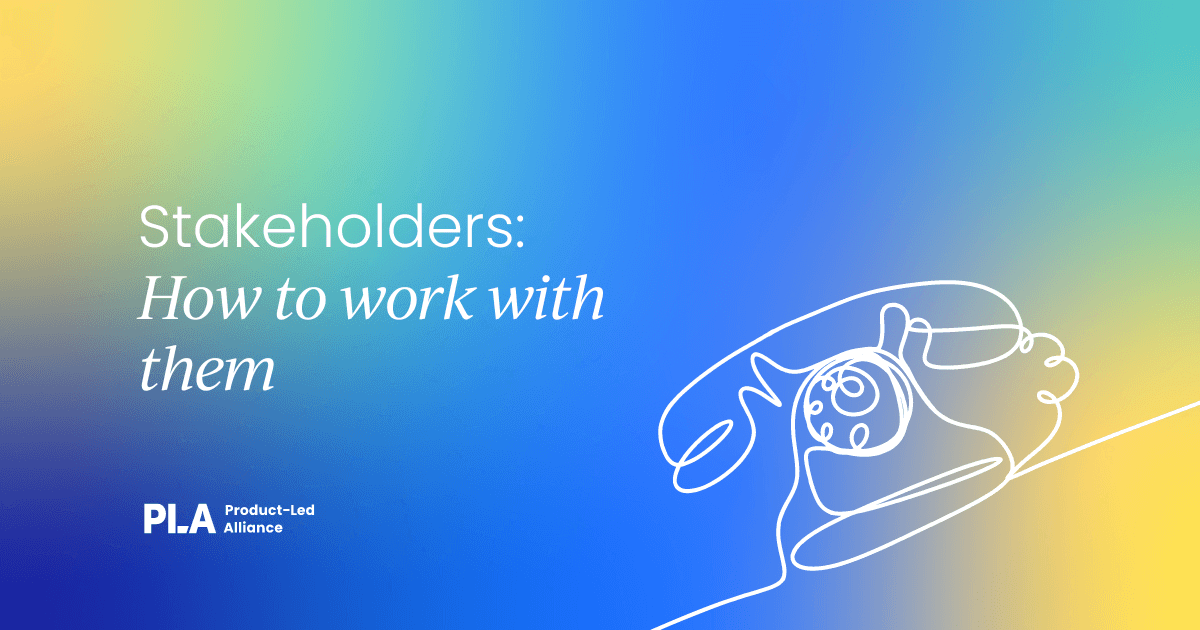
Outcome-based roadmap examples
Roadmap hierarchy
An outcome-based roadmap hierarchy is (you guessed it) structured as a hierarchy – outlining business strategy and product vision, then moving down the chain to goals, opportunities, and ideas. At the lowest levels, this roadmap is broken into features and stories.
This approach emphasizes how tasks and activities align with strategic goals, allowing your product team to link their day-to-day tasks with the overarching product vision.
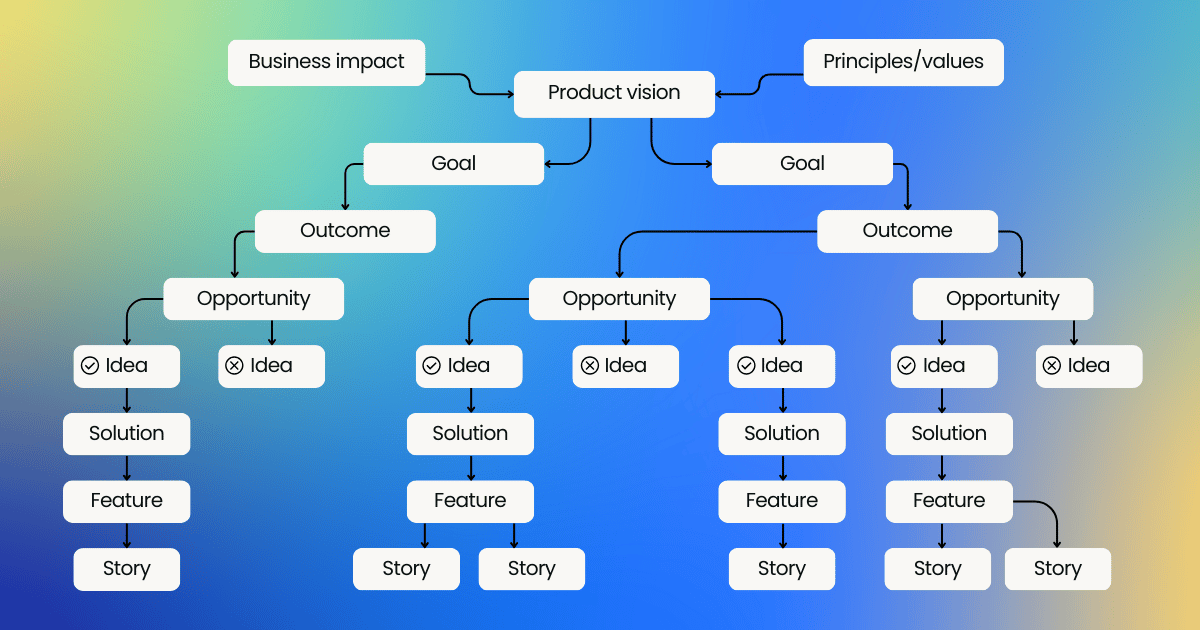
Timeline roadmap
A goal-driven timeline roadmap outlines a set of goals and the timelines set out for research, discovery, and delivery.
To increase flexibility over the product development process, delivery plans are kept as placeholders until your team selects a direction during discovery. This allows your team to research and solve the problem without bias towards a particular solution.
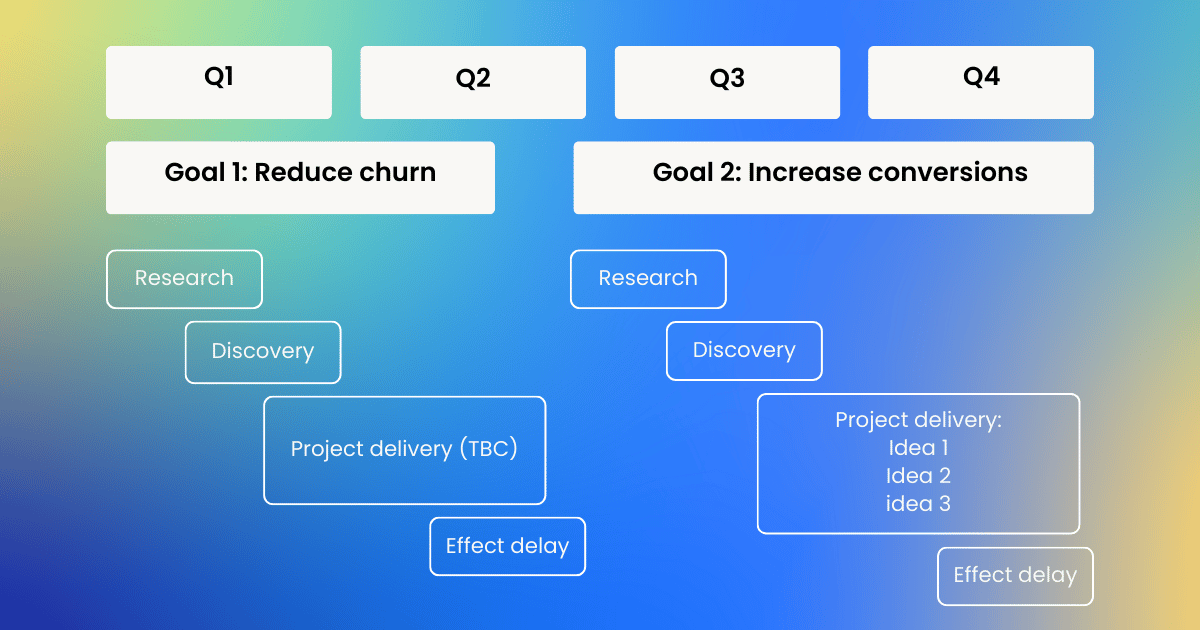
Release-specific roadmap
A simple outcome-driven roadmap presents release-specific information alongside the business goal it relates to and the key metrics tied to the project.
This allows your product team an at-a-glance understanding of upcoming projects and their impact on the overall product strategy.
The release-specific roadmap also emphasises accountability and continuous improvement.
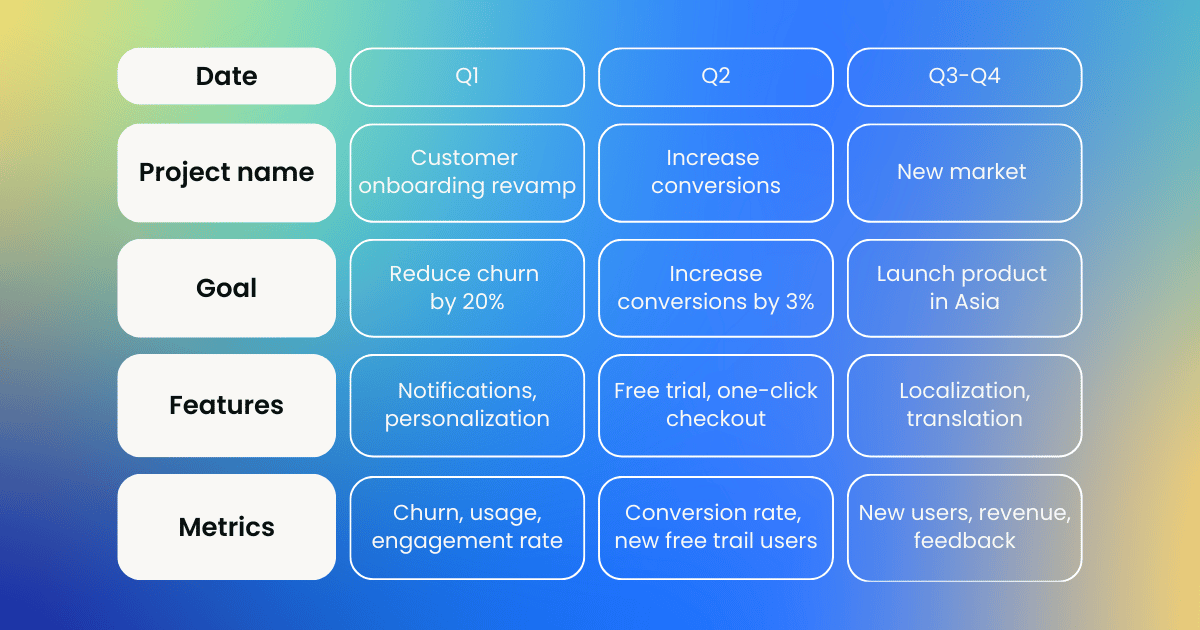
Are you making the switch from feature-based roadmaps to outcome-driven roadmaps? What advice would you give? Let us know, by continuing the conversation on our Slack community.



 Follow us on LinkedIn
Follow us on LinkedIn






